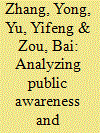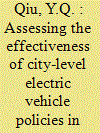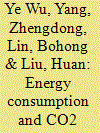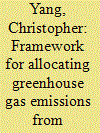|
|
|
Sort Order |
|
|
|
Items / Page
|
|
|
|
|
|
|
| Srl | Item |
| 1 |
ID:
125520


|
|
|
|
|
| Publication |
2013.
|
| Summary/Abstract |
This paper quantifies the recharging behaviour of a sample of electric vehicle (EV) drivers and evaluates the impact of current policy in the north east of England on EV driver recharging demand profiles. An analysis of 31,765 EV trips and 7704 EV recharging events, constituting 23,805 h of recharging, were recorded from in-vehicle loggers as part of the Switch EV trials is presented. Altogether 12 private users, 21 organisation individuals and 32 organisation pool vehicles were tracked over two successive six month trial periods. It was found that recharging profiles varied between the different user types and locations. Private users peak demand was in the evening at home recharging points. Organisation individual vehicles were recharged primarily upon arrival at work. Organisation pool users recharged at work and public recharging points throughout the working day. It is recommended that pay-as-you-go recharging be implemented at all public recharging locations, and smart meters be used to delay recharging at home and work locations until after 23:00 h to reduce peak demand on local power grids and reduce carbon emissions associated with EV recharging.
|
|
|
|
|
|
|
|
|
|
|
|
|
|
|
|
| 2 |
ID:
110376


|
|
|
|
|
| Publication |
2011.
|
| Summary/Abstract |
The aim of this paper is to analyze consumers' awareness towards electric vehicle (EV) and examine the factors that are most likely to affect consumers' choice for EV in China. A comprehensive questionnaire survey has been conducted with 299 respondents from various driving schools in Nanjing. Three binary logistic regression models were used to determine the factors that contribute to consumers' acceptance of EVs, their purchase time and their purchase price. The results suggest that:
(1)
Whether a consumer chooses an EV is significantly influenced by the number of driver's licenses, number of vehicles, government policies and fuel price.
(2)
The timing of consumers' purchases of an EV is influenced by academic degree, annual income, number of vehicles, government policies, the opinion of peers and tax incentives.
(3)
The acceptance of purchase price of EVs is influenced by age, academic degree, number of family members, number of vehicles, the opinion of peers, maintenance cost and degree of safety.
These findings will help understand consumer's purchase behavior of EVs and have important policy implications related to the promotions of EVs in China.
|
|
|
|
|
|
|
|
|
|
|
|
|
|
|
|
| 3 |
ID:
168307


|
|
|
|
|
| Summary/Abstract |
Diffusion of electric vehicles (EVs) is regarded as an important strategy for promoting renewable energy development and controlling CO2 emissions in China. Thus, several incentive measures and policies have been released by the pilot cities in China. The question arises as to whether these policies are effective in promoting the EV deployment. This paper assesses the effectiveness of various EV incentive policies at city level by using the data from 88 Chinese pilot cities. Our regression results show a positive relationship between EV sales volume and two demand-side policies: charging discount and infrastructure construction subsidy. However, purchase subsidy policy is found to have no significant effect. Parking benefits policy shows no effect on promoting EV sales. On the other hand, two supply side policies — model development award and manufacturing award — are not effective. We suggest that local governments may keep those two effective policies, phase out the purchase subsidy policy, terminate the parking benefits policy and suspend the model development award policy. The manufacturing award policy can either be paused or be bundled with other regulations or policies that make specific requirements for EV quality.
|
|
|
|
|
|
|
|
|
|
|
|
|
|
|
|
| 4 |
ID:
191405


|
|
|
|
|
| Summary/Abstract |
With the rising demands for personal vehicles of the growing middle class in India, their increasing quest for comfort and social status, the emissions from road transportation are increasing manifold times. To fulfil the dual need of increasing personal demand as well as lower vehicular emissions, it is important to replace all future vehicle purchase with purchase of electric vehicles (EVs). This study analyses the socio-psychological determinants of the process by which an individual might develop an intention to buy an EV in the near future. Using Structural Equation Modeling and mediation analysis, the interrelationships between the Theory of Planned Behavior (TPB) constructs along with three additional constructs, ‘‘cost’, ‘herd behavior’, and ‘personal norm’ are analyzed and several direct and indirect pathways in which intentions possibly form in people's mind are outlined. Subjective norms followed by perceived behavioral control emerge as the significant and direct intention formation pathway. Though cost, herd behavior, and personal norms alone do not influence intention formation, these factors mediates the TPB variables in forming intention to adopt EVs. Hence, the current EV promotion policies, primarily focused on subsidies need to be complemented with other attitudinal and norm-based nudges to promote faster EV adoption in India.
|
|
|
|
|
|
|
|
|
|
|
|
|
|
|
|
| 5 |
ID:
180110


|
|
|
|
|
| Summary/Abstract |
Given the growing severity of particulate matter (PM) and greenhouse gas pollution, the Korean government recently began supporting the use of eco-friendly vehicles, such as electric vehicles and hydrogen fuel cell vehicles. However, the uptake of these vehicles has been slower than anticipated because of the high purchase price and lack of infrastructure. Therefore, the Korean government has eased restrictions on liquefied petroleum gas (LPG) vehicles to encourage the vast majority of consumers to purchase LPG vehicles, expecting that they will serve as a stepping stone to switch from internal combustion engine vehicles to their eco-friendly counterparts. However, there have been only a few studies on consumer preferences for LPG vehicles in consideration of this amendment. To analyze consumer preferences for all fuel types, including LPG, this study used a discrete choice experiment combined with a reference-dependent model. The results showed a loss aversion tendency and asymmetric preferences among consumers with regard to vehicle choice. Based on these results, a simulation analysis was conducted to predict the future market share and PM pollution level. The findings indicated that the government's LPG vehicle deregulation policy could achieve positive PM reduction effects in the short term but none in the long term.
|
|
|
|
|
|
|
|
|
|
|
|
|
|
|
|
| 6 |
ID:
093467


|
|
|
|
|
| Publication |
2010.
|
| Summary/Abstract |
This paper compares battery electric vehicles (BEV) to hydrogen fuel cell electric vehicles (FCEV) and hydrogen fuel cell plug-in hybrid vehicles (FCHEV). Qualitative comparisons of technologies and infrastructural requirements, and quantitative comparisons of the lifecycle cost of the powertrain over 100,000 mile are undertaken, accounting for capital and fuel costs. A common vehicle platform is assumed. The 2030 scenario is discussed and compared to a conventional gasoline-fuelled internal combustion engine (ICE) powertrain. A comprehensive sensitivity analysis shows that in 2030 FCEVs could achieve lifecycle cost parity with conventional gasoline vehicles. However, both the BEV and FCHEV have significantly lower lifecycle costs. In the 2030 scenario, powertrain lifecycle costs of FCEVs range from $7360 to $22,580, whereas those for BEVs range from $6460 to $11,420 and FCHEVs, from $4310 to $12,540. All vehicle platforms exhibit significant cost sensitivity to powertrain capital cost. The BEV and FCHEV are relatively insensitive to electricity costs but the FCHEV and FCV are sensitive to hydrogen cost. The BEV and FCHEV are reasonably similar in lifecycle cost and one may offer an advantage over the other depending on driving patterns. A key conclusion is that the best path for future development of FCEVs is the FCHEV.
|
|
|
|
|
|
|
|
|
|
|
|
|
|
|
|
| 7 |
ID:
175232


|
|
|
|
|
| Summary/Abstract |
The construction of public-access electric vehicle charging piles is an important way for governments to promote electric vehicle adoption. The endogenous relationships among EVs, EV charging piles, and public attention are investigated via a panel vector autoregression model in this study to discover the current development rules and policy implications from the historical panel data in China. Five policies related to EV charging piles, EV purchase subsidies, commercial land prices, and retail gasoline prices are controlled as exogenous variables in the model. The results indicate that EV and charging piles diffusion do interact, and public attention plays a nexus role in EV and charging piles deployment. Reducing the electricity rate is the most effective policy approach to promote EV charging piles. Subsidising the construction cost has an insignificant impact on charging piles diffusion in this study, and several possible reasons have been discussed. The promotion effect of direct-current charging piles on EV sales is twice that of alternating-current charging piles in the one-year simulation of our model. Increasing the number of EV charging piles has a significant impact on battery electric vehicle sales but not on plug-in hybrid electric vehicle sales.
|
|
|
|
|
|
|
|
|
|
|
|
|
|
|
|
| 8 |
ID:
176696


|
|
|
|
|
| Summary/Abstract |
Despite the extensive use of demonstration projects, doubts remain on their effectiveness in promoting the commercialization of emerging technologies. To explore whether public demonstrations could stimulate innovation diffusion and to what extent the effects are, this paper conducted an empirical analysis of China's high-profile electric vehicle demonstration project based on a manually collected data set of 44 pilot cities from 2009 to 2015. The approach of difference-in-differences propensity score matching was used to address the selection bias of pilot cities, and the effects of demonstrating electric buses and electric commercial vehicles were further examined and discussed after a series of robustness check. The empirical results reveal that when controlling the impact of all policy incentives, the deployment of electric vehicles in the public sector has significantly stimulated the purchase of electric vehicles by individuals, especially in the pilot cities with more commercial vehicles, which provides new insights into the formulation of public procurement policies.
|
|
|
|
|
|
|
|
|
|
|
|
|
|
|
|
| 9 |
ID:
130461


|
|
|
|
|
| Publication |
2014.
|
| Summary/Abstract |
In 1896, a 33-year-old engineer working for the Detroit branch of Thomas Edison's Edison Illuminating Company traveled to New York for the firm's annual convention. The automobile was the obvious technology of the future by then, but it wasn't yet clear what would propel it: steam, electricity, or gasoline. Edison had been tinkering with batteries that could power a car, so he was interested to hear that the engineer from Detroit had invented a two-cylinder gasoline vehicle. After hearing a description of the car, Edison immediately recognized its superiority.
|
|
|
|
|
|
|
|
|
|
|
|
|
|
|
|
| 10 |
ID:
115152


|
|
|
|
|
| Publication |
2012.
|
| Summary/Abstract |
Vehicle electrification has been seriously considered as an industry revolution to achieve sustainable transportation in China. Hybrid electric vehicles (HEV), plug-in hybrid electric vehicles (PHEV) and pure electric vehicles (EV) are being demonstrated in scores of large cities. We select three well-developed regions (Jing-Jin-Ji, Yangtze-River-Delta and Pearl-River-Delta) to explore regional growth patterns for the light-duty passenger vehicle fleet and develop various scenarios for the penetration of HEV, PHEV and EV during 2010-2030. Per-kilometre and fleet well-to-wheels (WTW) petroleum use, fossil energy and CO2 emissions are evaluated among various technology options. Promotion of PHEV and EV could help cut per-kilometre petroleum use to a great extent; however, to achieve a clear reduction benefit in oil demand for a fleet in three regions takes time. The effort to mitigate CO2 emissions is much more difficult than lowering fossil energy use or oil consumption. This is especially true for the Jing-Jin-Ji Region where coal is an overwhelming power source. In those regions with a high share of coal power, HEV is a better option than PHEV or EV to reduce WTW CO2 emissions. In the Pearl-River-Delta region with a much cleaner electricity mix, promotion of EV could achieve a more significant CO2 reduction.
|
|
|
|
|
|
|
|
|
|
|
|
|
|
|
|
| 11 |
ID:
190602


|
|
|
|
|
| Summary/Abstract |
A major challenge faced by policymakers has been determining appropriate subsidy amounts for household energy investments. This can result in inequitable support being either insufficient or excessive. Equitable reverse auctions offer a novel approach to address these issues. Households can bid an amount as a subsidy from the government that they require to go ahead with an energy investment. The lowest bids are successful in a reverse auction, allowing for cost-effective government support. The novel part is the pursuit of equity, as these auctions can occur separately for a pre-determined number of carefully chosen socio-economic groups. Equitable reverse auctions would lower inequality by design, relative to a common benchmark of equal subsidies, for a given government budget and environmental outcomes. Compared to a standard reverse auction, an equitable reverse auction will have greater equality by design but lower cost-effectiveness. However, the design of equitable reverse auctions is cost-effective within each socio-economic group. Non-additional subsidy spending would be reduced through reverse auctions. Equitable reverse auctions would be flexible to fit circumstances across countries, time, and technologies.
|
|
|
|
|
|
|
|
|
|
|
|
|
|
|
|
| 12 |
ID:
191368


|
|
|
|
|
| Summary/Abstract |
Electric vehicles (EVs) can play an ancillary role in energy and electricity system management. Vehicle-to-Grid (V2G) technology allows EV batteries to be discharged back into the grid. This technology enables charging when electricity prices are low and there is abundance of electricity in the grid and discharging when electricity costs are high and there is high load in the grid. The current study estimates the combination of financial compensation (FC) incentives (reduction in monthly electricity bill) and minimum guaranteed charge (MC) that would be needed to increase the acceptance of V2G technology among Norwegians. Estimating a multi-equation econometric model, we investigate how socioeconomic, geographical, and psychological exogenous variables predict the level of FC and required MC, as well as the relationship between FC and MC. We found that there is a mutual and negative relationship between FC and MC. Based on the MC-FC economic relationship, the V2G system is more likely to be accepted by older people, people who perceive the V2G system as more useful, people who have EV experience, and individuals with a higher level of trust in the V2G system. The group with strong trust in V2G demands less FC for a given value of MC. When MC is reduced, younger age groups (18–22) are more likely to demand higher FC. Our estimations also show that people demand an average reduction in electricity bills of 144 USD (72% of the average monthly electricity bill) as compensation for V2G investment while they would also use V2G if their electric car’s battery had a minimum level of 71% power. Monetary incentives based on socioeconomic status, options in the interface allowing the user to easily override the standards, and trusted methods of calculating the revenue may be considered in order to reduce financial expectations and concerns regarding minimum battery charges.
|
|
|
|
|
|
|
|
|
|
|
|
|
|
|
|
| 13 |
ID:
192763


|
|
|
|
|
| Summary/Abstract |
Electric vehicles (EVs) can play an ancillary role in energy and electricity system management. Vehicle-to-Grid (V2G) technology allows EV batteries to be discharged back into the grid. This technology enables charging when electricity prices are low and there is abundance of electricity in the grid and discharging when electricity costs are high and there is high load in the grid. The current study estimates the combination of financial compensation (FC) incentives (reduction in monthly electricity bill) and minimum guaranteed charge (MC) that would be needed to increase the acceptance of V2G technology among Norwegians. Estimating a multi-equation econometric model, we investigate how socioeconomic, geographical, and psychological exogenous variables predict the level of FC and required MC, as well as the relationship between FC and MC. We found that there is a mutual and negative relationship between FC and MC. Based on the MC-FC economic relationship, the V2G system is more likely to be accepted by older people, people who perceive the V2G system as more useful, people who have EV experience, and individuals with a higher level of trust in the V2G system. The group with strong trust in V2G demands less FC for a given value of MC. When MC is reduced, younger age groups (18–22) are more likely to demand higher FC. Our estimations also show that people demand an average reduction in electricity bills of 144 USD (72% of the average monthly electricity bill) as compensation for V2G investment while they would also use V2G if their electric car’s battery had a minimum level of 71% power. Monetary incentives based on socioeconomic status, options in the interface allowing the user to easily override the standards, and trusted methods of calculating the revenue may be considered in order to reduce financial expectations and concerns regarding minimum battery charges.
|
|
|
|
|
|
|
|
|
|
|
|
|
|
|
|
| 14 |
ID:
111330


|
|
|
|
|
| Publication |
2012.
|
| Summary/Abstract |
Future fleets of vehicles may include electric vehicles (EVs) or hybrid electric vehicles (HEVs) because of potential fuel savings. Recent demonstration of diesel parallel hybrids in a delivery fleet led to fuel economy improvements, and hybrid bus demonstrations exhibited twice the fuel economy of the conventional bus. Fleet ownership may include management of a fleet of vehicles as small as 10 units and as large as hundreds or thousands. In addition to fuel savings, the newer extended range electric vehicles (EREVs) and pure EVs permit vehicle to grid (V2G) opportunities. These V2G opportunities may present additional revenue for fleets by providing ancillary services to local grid independent system operators (ISOs), provided that the burden of driving and V2G services do not accelerate the degradation of the battery systems in these vehicles. The subject of this study is to determine the financial risks associated with accelerated battery degradation in a V2G-enabled EREV fleet expected to perform ancillary service duty while charging in addition to the normal loads of drive cycle duty. We determine that battery cycle life during V2G duty is a critical parameter, which can determine whether or not the business model is viable.
|
|
|
|
|
|
|
|
|
|
|
|
|
|
|
|
| 15 |
ID:
124624


|
|
|
|
|
| Publication |
2013.
|
| Summary/Abstract |
This paper describes a number of different allocation methods for assigning greenhouse gas emissions from electricity generation to charging plug-in electric vehicles. These methods for calculating the carbon intensity of electricity are discussed in terms of merits and drawbacks and are placed into a framework to aid in understanding the relation with other allocation methods. Three independent decisions are used to define these methods (average vs. marginal, aggregate vs. temporally-explicit, and retrospective vs. prospective). This framework is important because the use of different methods can lead to very different carbon intensities and studies or analyses that do not properly identify the methods used can confuse policymakers and stakeholders, especially when compared to other studies using different methods.
|
|
|
|
|
|
|
|
|
|
|
|
|
|
|
|
| 16 |
ID:
150770


|
|
|
|
|
| Summary/Abstract |
There has been a concentrated effort by European countries to increase the share of electric vehicles (EVs) and an important factor in the rollout of the associated infrastructure is an understanding of the charging behaviours of existing EV users in terms of location of charging, the quantity of energy they require, charge duration, and their preferred mode of charging. Data were available on the usage of charging infrastructure for the entire island of Ireland since the rollout of infrastructure began. This study provides an extensive analysis of this charge event data for public charging infrastructure, including data from fast charging infrastructure, and additionally a limited quantity of household data. For the household data available, it was found that EV users prefer to carry out the majority of their charging at home in the evening during the period of highest demand on the electrical grid indicating that incentivisation may be required to shift charging away from this peak grid demand period. Car park locations were the most popular location for public charging amongst EV users, and fast chargers recorded the highest usage frequencies, indicating that public fast charging infrastructure is most likely to become commercially viable in the short- to medium-term.
|
|
|
|
|
|
|
|
|
|
|
|
|
|
|
|
| 17 |
ID:
169893


|
|
|
|
|
| Summary/Abstract |
Fuel economy regulation is a powerful instrument to reduce CO2 emissions of vehicles. CO2 emissions from transport have to be dramatically reduced to reach ambitious CO2 targets, but fuel economy standards below 75 gCO2/km (72.8 MPG) cannot be reached with combustion engine vehicles but require plug-in electric vehicles (PEVs). However, the specific relationship between stringent fuel economy standards and PEV market share is unclear. Here, we analyse CO2 fleet targets in Europe where Regulation (EU) 2019/631 sets a target of 59.4 gCO2/km (90.9 MPG) in 2030. We use data of 3.2 million records with model-specific car sales in Europe from 2010 to 2016 to project future sales and CO2 emissions of all major vehicle manufacturers. We analyse the required PEV sales for these manufacturers to fulfill the CO2 targets and compare them to the manufacturers' announced sales targets. Our results demonstrate that regulation's target leads to PEV sales shares between 27 and 41% in 2030. The lower value is required if all manufacturers only sell BEV and the upper if only PHEV. In conclusion, ambitious CO2 fleet regulation leads to fast market diffusion of PEVs, but the current regulation is less ambitious than car maker targets in 2025.
|
|
|
|
|
|
|
|
|
|
|
|
|
|
|
|
| 18 |
ID:
127249


|
|
|
|
|
| Publication |
2014.
|
| Summary/Abstract |
This study analyses battery electric vehicles (BEVs) in the future German power system and makes projections of the BEVs hourly load profile by car size ('mini', 'small', 'compact' and 'large'). By means of a power plant dispatching optimisation model, the study assesses the optimal BEV charging/discharging strategies in grid-to-vehicle (G2V) and vehicle-to-grid (V2G) schemes. The results show that the 2% rise in power demand required to power these BEVs does not hamper system stability provided an optimal G2V scheme is applied. Moreover, such BEV deployment can contribute to further integrating wind and solar power generation. Applying a V2G scheme would increase the capacity factors of base and mid-load power plants, leading to a higher integration of intermittent renewables and resulting in a decrease in system costs. However, the evaluation of the profitability of BEVs shows that applying a V2G scheme is not a viable economic option due to the high cost of investing in batteries. Some BEV owners would make modest profits (€6 a year), but a higher number would sustain losses, for reasons of scale. For BEVs to become part of the power system, further incentives are necessary to make the business model attractive to car owners
|
|
|
|
|
|
|
|
|
|
|
|
|
|
|
|
| 19 |
ID:
111359


|
|
|
|
|
| Publication |
2012.
|
| Summary/Abstract |
Electric drive vehicle technologies are being considered as possible solutions to mitigate environmental problems and fossil fuels dependence. Several studies have used life cycle analysis technique, to assess energy use and CO2 emissions, addressing fuels Well-to-Wheel life cycle or vehicle's materials Cradle-to-Grave. However, none has considered the required infrastructures for fuel supply. This study presents a methodology to evaluate energy use and CO2 emissions from construction, maintenance and decommissioning of support infrastructures for electricity and fossil fuel supply of vehicles applied to Portugal case study. Using Global Warming Potential and Cumulative Energy Demand, three light-duty vehicle technologies were considered: Gasoline, Diesel and Electric. For fossil fuels, the extraction well, platform, refinery and refuelling stations were considered. For the Electric Vehicle, the Portuguese 2010 electric mix, grid and the foreseen charging point's network were studied. Obtained values were 0.6-1.5 gCO2eq/km and 0.03-0.07 MJeq/km for gasoline, 0.6-1.6 gCO2eq/km and 0.02-0.06 MJeq/km for diesel, 3.7-8.5 gCO2eq/km and 0.06-0.17 MJeq/km for EV. Monte Carlo technique was used for uncertainty analysis. We concluded that EV supply infrastructures are more carbon and energetic intensive. Contribution in overall vehicle LCA does not exceed 8%.
|
|
|
|
|
|
|
|
|
|
|
|
|
|
|
|
| 20 |
ID:
150355


|
|
|
|
|
| Summary/Abstract |
One of the key issues in modern energy technology is managing the imbalance between the generated power and the load, particularly during times of peak demand. The increasing use of renewable energy sources makes this problem even more acute. Various existing technologies, including stationary battery energy storage systems (BESS), can be employed to provide additional power during peak demand times. In the future, integration of on-board batteries of the growing fleet of electric vehicles (EV) and plug-in hybrid electric vehicles (PHEV) into the grid can provide power during peak demand hours (vehicle-to-grid, or V2G technology).
|
|
|
|
|
|
|
|
|
|
|
|
|
|
|
|
|
|
|
|
|